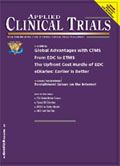Data Integration in the Age of Global Trials
Applied Clinical Trials
The difference a clinical trial management system can make in integrating a global workforce.
The average lifespan of a U.S. citizen increased by more than 30 years in the 20th century,1 and the life sciences industry played an instrumental role in realizing this achievement. The industry continues to innovate today, working toward breakthroughs that will further advance the treatment of serious and chronic disease, as well as open new commercial avenues for biotech and pharmaceutical companies.

As life sciences organizations press forward in the development of treatments, they face unprecedented operational challenges, including flat and even declining productivity, rising research and development costs (closing in on $1 billion to bring a new drug or treatment to market),2 more complex preapproval trials and large postapproval studies driven by the shift toward biological agents, and increasing regulatory demands. In this environment, life sciences organizations are increasingly seeking greater operational efficiency and productivity in the expensive and time-consuming clinical development process.

The industry is taking a hard look at clinical trials—the cost of which has increased by 40% over the last decade, according to industry analyst Frost & Sullivan.3 As such, the focus on reducing costs and elevating R&D productivity is driving tremendous change in the way life sciences organizations conduct trials and how they capture, store, integrate, analyze, and report critical trial-related data to yield new insights that drive down costs. Multinational pharmaceutical companies have increasingly included China in early development to maximize the use of global studies for local registration and to help reduce clinical trial enrollment bottlenecks and costs.
Two trends hold significant potential for multinational pharmaceutical development: global trials and streamlined data integration. Clinical trial management systems (CTMS) is a way to support these trends and help organizations reduce costs, increase productivity, and respond more agilely to the ever-changing global clinical landscape.
Going global
The number of global clinical trials is growing rapidly and the industry is seeing a significant shift in trial location from North America/Western Europe to the Asia-Pacific region. Analysts predict that between 2008 and 2010, the percentage of trials conducted in North America/Western Europe will fall from 55% to 38%.4 At the same time, the market expects to see further expansion in China over the next few years as the result of the new $124 billion government health care reform aimed at providing universal health insurance to 90% of the population by 2011 and expanding investment in primary care facilities in rural regions.5 This program is expected to enable access to millions of rural patients, who previously were not able to participate in clinical trials due to lack of basic medical insurance coverage.
Several other factors are fueling the trend toward globalization. Expansive, treatment-naïve patient populations to support larger, more extensive trials, as well as cost savings top the list. For example, clinical trials conducted in China and India can cost 60% less than trials conducted in North America or parts of Western Europe.6 In some Asian markets, investigator and site fees are approximately one-half of those in the United States. Additionally, expenses incurred from the sponsor for providing trial-related medication, investigations, and hospitalization can be as low as 30 percent of those in America.7
The shift toward global trials has many implications for sponsors and contract research organizations (CROs), which need to support all operational aspects of global trials—from multiple languages, logistics, access control, and regional requirements to region-specific business processes. Furthermore, sponsors and CROs must understand and meet local regulatory requirements, which add a new layer of complexity to the trial management process.

As such, some organizations turn to commercial CTMS—typically implemented as enterprise applications—to manage global trials more efficiently. Enterprise CTMS provide a centralized trial repository that enables standard trial management processes across the enterprise and provides end users, who increasingly are more geographically diverse, with real-time data visibility into study progress. However, organizations must balance the need to empower their employees with access to available information against the need for information security—keeping tight control over data access, allowing only those with proper authorization to access key data.
Flexibility in adapting to meet the unique requirements and needs of investigators around the globe is also important when pursuing a global trial strategy. To capitalize on the true potential of broader research and lower costs offered by global clinical trials, organizations must manage global trials as an integrated initiative as opposed to merely a series of trials conducted in different locations. That said, a truly globalized approach to trials will require near real-time visibility across all sites to drive and guide decisions and trial direction. To achieve this objective, sponsors could benefit from global unified CTMS systems with built-in function that supports specific regional needs.
The current mindset, however, is still more or less fixed on the traditional North American/Western European requirements and supporting prevailing business needs. This view must change if we are to transition to a truly global system to ensure individuals and departments have an understanding of their roles in the business process. Regional units need to understand how their work affects others in the process so that effective collaboration can take place. It is also important to assess the impact or implication that local infrastructure and culture might have on conducting clinical trials in developing countries.
Innovative CTMS solutions that are very site-focused, pragmatic, and offer flexibility to adapt to the local infrastructure may help trial sponsors and CROs overcome several inherent barriers, including the following:
Upholding standards and ensuring data integrity. Global clinical trials present challenges in terms of maintaining consistent standards of care across sites in various countries. Study sponsors must take this into account as they design trials and work to achieve protocol compliance, patient safety, and ethical standards. CTMS can help sponsors and CROs to support trial sites in ensuring adherence to various standards, such as International Conference on Harmonization of Technical Requirements for Registration of Pharmaceuticals for Human Use (ICH) E6 Good Clinical Practice Guidelines, by clearly defining patient and care protocols, presenting a structured system to ensure data integrity, and facilitating compliance monitoring. Such systems also support investigative sites' efforts to ensure appropriate follow-up via functions that enable an investigator to create a follow-up schedule at a moment's notice for a trial participant.
As important, CTMS can help to support the growth of local CROs in emerging markets—providing a turn-key solution that they can leverage to design, implement, and manage trials that meet international standards, and enabling them to gain a foothold in a growing industry.
Adapting to local health care delivery networks. To succeed in an era of global trials, sponsors, CROs, and their systems should be able to adapt to variations in health care delivery and data collection across countries and regions.
For example, in China, clinical trial sites are located primarily in cities at larger, government-certified health care facilities because access to primary health care facilities is limited in many remote areas. As a result, many trial participants may not live locally, making follow-up a challenge after a patient is released from the hospital. Addressing this challenge requires flexibility and innovation. A large Chinese CRO has, for example, proposed utilizing mobile phones as a component of its site management system. The proposed system would allow investigators to send alerts or messages via Short Message Service (SMS), or push reminders to patients regarding visits. This type of collaborative tool, along with better data visibility, will help investigators better manage their trial subjects, clinical research associates (CRAs), and sites, and increase overall study compliance.
Some trial sponsors and CROs are exploring the possibility of leveraging personal digital assistants (PDAs) as another means of accessing and entering data into the CTMS. In some regions, investigators do not carry or have access to laptops in a clinical setting, but they do carry PDAs. In this case, the PDA provides a more effective way to collect, view, and manage critical trial information.
Flexibility is also essential to ensuring prompt and correct payments to trial investigators and sites—the lifeblood of any trial. The payment process, always complex, becomes even more onerous with global trials as structures, payment processes, and currencies can vary across regions. For example, investigators in North America and Western Europe are demanding better visibility into the payment process, while in China, payments to investigators still remains too much of a sensitive topic to be captured in CTMS. Moving forward, CTMS must provide the flexibility required to accommodate regional variations in payment structures to ensure prompt and accurate payments.
Building and maintaining relationships with sites. As the centers of influence for clinical trials expand to the Asia-Pacific region and beyond, life sciences organizations and CROs must focus on building strong and personalized relationships with investigators around the globe to foster loyalty, just as they would for trials conducted in North America and Western Europe. CTMS can support strategies to strengthen these relationships, such as providing investigators with fingertip access to critical information with easy-to-use productivity tools, such as PDAs and SMS, which make conducting trials less time- and resource-consuming.
Cell phone usage is ubiquitous in China. SMS is widely used by people of all age groups to communicate in transit as it is more cost efficient to send a text message than to place a call. One of the largest domestic CROs in China has been routinely using SMS to send reminder messages to investigators regarding planned site visits, as well as to patients to remind them of scheduled study visits.
Leading CTMS vendors have adopted a customer relationship management paradigm and methodology, and developed robust features to allow companies to deliver these capabilities. By assisting investigators and providing them with the best possible trial experience, individual companies will set themselves apart from their peers and support investigator retention, regardless of the trial location.
CTMS and the integration challenge
The goal of boosting R&D productivity while driving down costs can present monumental data integration challenges, regardless of where a trial is conducted. To foster collaboration and accelerate decision-making about proceeding with, adapting, or halting a specific trial, today's sponsors, along with their CRO partners, require instant access to myriad data that range far beyond clinical and lab information to encompass adverse events, enrollment, and even financial data. As important, the individuals requiring this data may be located in the same building or on the other side of the world and may work for various organizations.
Traditionally, life sciences organizations, like their counterparts in other industries, have built customized, point-to-point integrations to connect data from siloed systems. As IT environments increase in complexity, this approach becomes increasingly complex to sustain as development and maintenance costs escalate dramatically. The active merger and acquisition environment in the life sciences industry further underscores the need for streamlined integration as some of the industry's largest and most complex organizations look to combine operations.
How do CTMS solutions factor into the integration story? In the era of electronic data capture (EDC) and interactive voice response systems (IVRS), CTMS solutions may not be the primary system of entry for critical patient and enrollment data. Nonetheless, they play an expanded role in ensuring that a trial proceeds on schedule and on budget.
To get a clear picture of a study, view actual subject enrollment against plan, track actual payments against budget, and forecast workload and resource needs, end users must be able to use CTMS solutions to access accurate data on information such as enrollment, as well as CRF completion. Manually entering data into the CTMS after it has been entered into other systems is highly undesirable, as it is labor-intensive and error-prone, and requires costly conflict resolutions. Thus, integration with systems such as EDC, IVRS, and back office financial systems becomes essential.
With each integration, however, complexity and costs escalate. Life sciences organizations are looking at streamlined solutions that will simplify integration and enable them to deliver data to the CTMS to drive efficiency and accelerate trial results.
Vendors with products/applications built on standards-based open architecture offer compelling value in assisting biopharmaceutical companies in their integration efforts. Service-oriented architecture offers a new way to build open applications that can be shared by common processes across multiple applications. Service-oriented architecture essentially breaks down the traditional barriers between systems by providing a common platform on which to build solutions that can be shared as "build once; use many times" interoperable services.
Many software providers are making significant progress in developing next-generation service-oriented architecture-based applications for the clinical industry. These solutions will provide better support for business processes that span multiple applications and will reduce the need for costly point-to-point integration. As important, they will support an organization's efforts to deliver information and intelligence to the fingertips of trial managers and investigators, often via CTMS systems, ultimately helping to drive new levels of efficiency and precision.
On the horizon
The life sciences industry has driven advancements that were beyond the imagination of industry experts only a few decades ago. This spirit of innovation continues today, helping the industry to surmount new challenges that range from declining R&D productivity to growing regulatory complexity.
Life sciences organizations are increasingly looking to IT to help them drive down clinical trial costs while accelerating time to market. For example, collaboration tools that improve the productivity of all clinical trial participants—regardless of their location—will afford significant benefits. In this environment, next-generation CTMS solutions that are built to support business processes instead of focusing on data collection are also coming to the fore, while affording the flexibility required to support unique regional requirements. Looking ahead, widespread adoption of service-oriented architecture and turnkey integration solutions should lead to technology solutions that are easier to use, implement, connect, and maintain—enabling life sciences organization to reap the full benefits of the eClinical vision.
Rachel Yang, MD, PhD, is Director, Product Strategy, Oracle Health Sciences Global Business Unit, Oracle Corporation, 500 Oracle Parkway, Redwood Shores, CA 94065, email: [email protected].
References
Centers for Disease Control and Prevention, http://cdc.gov/mmwr/preview/mmwrhtml/00056796.htm
J. DiMasi, R. Hansen, H. Grabowski, "The Price of Innovation: New Estimates of Drug Development Costs," Journal of Health Economics, 22 (2) 151-185 (2003).
P. Webster, "Clinical Development Costs Skyrocket to New Levels," Frost & Sullivan, Market Insights, December 8, 2004.
W. McDonnell and H. Mooraj, Clinical Trials Are Moving Out (AMR Research, Boston, MA, 2008).
E. Wong, "China Plans Universal Health Care," The New York Times, January 22, 2009.
R. Collier, "Rapidly Rising Clinical Trial Costs Worry Researchers," Canadian Medical Association Journal, 180 (3) (2009).
N. Varawalla, "Conducting Clinical Trials in Asia," Applied Clinical Trials, June 2006.

Behind the Buzz: Why Clinical Research Leaders Flock to SCOPE Summit
February 7th 2025In this episode, we meet with Micah Lieberman, Executive Conference Director for SCOPE Summit (Summit for Clinical Ops Executives) at Cambridge Innovation Institute. We will dive deep into the critical role of collaboration within the clinical research ecosystem. How do we bring together diverse stakeholders—sponsors, CROs, clinical trial tech innovators, suppliers, patients, sites, advocacy organizations, investors, and non-profits—to share best practices in trial design, program planning, innovation, and clinical operations? We’ll explore why it’s vital for thought leaders to step beyond their own organizations and learn from others, exchanging ideas that drive advancements in clinical research. Additionally, we’ll discuss the pivotal role of scientific conferences like SCOPE Summit in fostering these essential connections and collaborations, helping shape the future of clinical trials. Join us as we uncover how collective wisdom and cross-industry partnerships are transforming the landscape of clinical research.
Reaching Diverse Patient Populations With Personalized Treatment Methods
January 20th 2025Daejin Abidoye, head of solid tumors, oncology development, AbbVie, discusses a number of topics around diversity in clinical research including industry’s greatest challenges in reaching diverse patient populations, personalized treatment methods, recruitment strategies, and more.